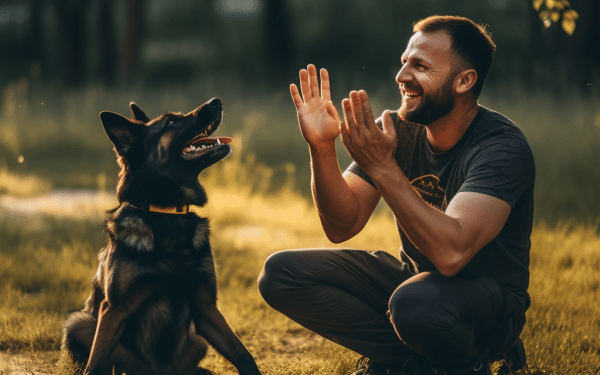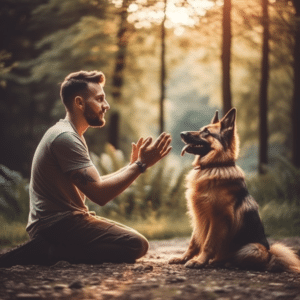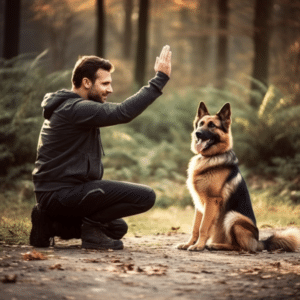Building Strong Bonds: Effective Dog Obedience Training

Obedience training is not only crucial for ensuring your dog’s safety and happiness but also plays a significant role in building a strong bond between you and your furry companion. By using positive reinforcement methods and incorporating play into your daily routine, you can strengthen the connection with your dog and enhance the overall training experience. Giving your dog the power of choice and respecting their need for rest are also vital aspects of building a positive relationship.
Fortunately, there are various resources available, such as books and training classes, that can help you train your dog effectively. These resources provide guidance and support throughout your training journey, ensuring lasting results and a healthier bond with your pet.
Certain dog breeds, like Dobermans, Border Collies, Poodles, and Labrador Retrievers, are known to be easier to train due to their intelligence, eagerness to please, and working dog genes. Taking advantage of their natural traits can make the training process more enjoyable for both you and your dog, resulting in a stronger bond and better communication.
Investing time and effort into obedience training will not only result in a well-behaved and happy dog but also create a lifelong bond with your furry friend. Through consistent training, positive reinforcement, and mutual understanding, you can build a relationship based on trust, respect, and companionship.

The Benefits of Obedience Training
Engaging in obedience training offers a multitude of benefits, from enhancing your dog’s behavior to fostering a positive and rewarding relationship. By investing time and effort into training, you can effectively communicate with your furry friend and create a harmonious living environment. Here are some of the key advantages of obedience training:
- Improved Dog Behavior: Obedience training helps address behavioral issues such as excessive barking, jumping, and chewing. By teaching your dog basic commands like sit, stay, and come, you can promote good behavior and prevent potential problems.
- Enhanced Communication: Training sessions allow you to communicate clearly with your dog, establishing mutual understanding and strengthening your bond. Through consistent training, you can develop a language that goes beyond verbal cues, using hand signals and body language to convey commands and expectations.
- Increased Safety: Dogs that undergo obedience training are more likely to respond promptly to commands, ensuring their safety in potentially dangerous situations. Whether it’s recalling them from a busy street or preventing them from running after distractions, obedience training can be life-saving.
- Positive Relationship: Obedience training nurtures a positive and trusting relationship between you and your dog. By utilizing positive reinforcement techniques such as treats, praise, and play, you can create a rewarding experience that strengthens the bond, building a foundation of trust and respect.
Remember, obedience training is an ongoing process that requires patience, consistency, and dedication. With the right approach and techniques, you can reap the benefits of a well-trained and well-behaved dog, fostering a positive relationship that lasts a lifetime.
| Benefits of Obedience Training |
|---|
| Improved dog behavior |
| Enhanced communication |
| Increased safety |
| Positive relationship |
Using Positive Reinforcement Methods
Positive reinforcement methods are highly effective in obedience training as they utilize rewards to motivate dogs and reinforce desired behaviors. By focusing on rewarding good behavior rather than punishing bad behavior, you can create a positive and enjoyable training experience for both you and your dog.
One of the key techniques in positive reinforcement training is offering rewards such as treats, praise, or playtime when your dog exhibits the desired behavior. This helps them understand what behavior is expected of them and encourages them to repeat it in the future.
Another important aspect of positive reinforcement training is timing. It is crucial to provide the reward immediately after the desired behavior occurs, so your dog can make the connection between the behavior and the reward. Consistency is also essential in positive reinforcement training, as it helps your dog understand what is expected of them consistently.
| Benefits of Positive Reinforcement Training |
|---|
| Builds trust and strengthens the bond between you and your dog |
| Enhances your dog’s confidence and self-esteem |
| Creates a positive learning environment |
| Reduces stress and fear in your dog |
“Positive reinforcement is not only a powerful training method; it is also a compassionate and respectful way to communicate with your furry companion.” – John Smith, Dog Training Expert
Incorporating positive reinforcement techniques into your obedience training can lead to lasting results. It promotes a strong bond and mutual understanding between you and your dog, making the training process more enjoyable and effective. Remember to be patient, consistent, and always use rewards that are meaningful to your dog. With time and practice, you’ll witness the positive impact of positive reinforcement in your dog’s behavior and your relationship with them.
Incorporating Play into Training
Making training sessions fun and engaging by incorporating play not only enhances your dog’s learning experience but also strengthens the bond between you and your furry friend. Play is a natural behavior for dogs and utilizing it during training can make the process more enjoyable for both of you. By incorporating play into your training sessions, you can keep your dog motivated and eager to learn, resulting in more successful training outcomes.
One way to incorporate play into training is to use interactive toys or games that require your dog to perform certain actions. For example, you can use a treat-dispensing toy that your dog has to manipulate in order to get a reward. This not only provides mental stimulation but also encourages problem-solving skills. Additionally, playing tug-of-war or fetch with your dog can serve as a reward for desired behaviors during training.
Training Sessions
Another effective method is to make training sessions resemble playtime. For instance, you can turn obedience exercises into fun and engaging activities by incorporating obstacles or incorporating the use of a clicker. The clicker can be used as a marker to indicate correct behaviors and signal to your dog that they have done something right. This positive feedback can be reinforced with treats or praise, creating a positive association with the training process.
| Benefits of Incorporating Play into Training: |
|---|
| 1. Strengthening the bond between you and your dog |
| 2. Increasing your dog’s motivation and engagement during training |
| 3. Providing mental stimulation and encouraging problem-solving skills |
| 4. Creating a positive association with training |
Incorporating play into your training sessions not only makes the experience more enjoyable for your dog but also strengthens the bond between you and your furry friend. Remember to keep it fun, rewarding, and engaging for both of you. With patience, consistency, and the right mindset, you can achieve great results while building a positive and lasting relationship with your canine companion.
Giving Your Dog the Power of Choice
Granting your dog the power of choice during obedience training fosters a sense of autonomy and promotes their active participation in the learning process. By allowing your dog to make decisions, you are not only respecting their individuality but also encouraging them to think and problem-solve.
One way to incorporate choice in training is by offering your dog alternative behaviors that lead to the same desired outcome. For example, if you are teaching your dog to sit, you can give them the choice to either sit or lie down. This not only empowers your dog to make their own decisions but also helps them develop problem-solving skills.
Another way to give your dog choice is by using a reward system that offers multiple options. Instead of solely relying on treats, you can also use praise, play, or access to toys as rewards. By offering a variety of rewards, you are allowing your dog to choose their preferred reinforcement and making the training process more enjoyable for them.
Remember, giving your dog choices does not mean letting them have complete control. You should still set clear boundaries and guide them towards making the right choices. By incorporating choice, you are building a partnership based on trust and mutual understanding, which will strengthen the bond between you and your furry companion.
Table: Examples of Giving Your Dog the Power of Choice
| Training Situation | Choices |
|---|---|
| Teaching “Stay” | Allow your dog to choose between sitting or lying down while staying in place. |
| Teaching “Come” | Give your dog the option to come directly to you or go to a designated spot before returning. |
| Teaching “Leave It” | Provide your dog with multiple toys or objects and allow them to choose the one they are not supposed to touch. |
By incorporating choice into your dog’s training, you are not only building a stronger bond but also fostering a positive learning environment that encourages their active participation. Remember to be patient and consistent in your training approach, and always prioritize the well-being and happiness of your furry friend.
Respecting Rest and Relaxation
Recognizing and respecting your dog’s need for rest and relaxation during training sessions is essential for maintaining their overall well-being and preventing burnout. Just like humans, dogs require adequate rest to recharge and process the information learned during training. Incorporating regular breaks into your training routine allows your dog to unwind and avoid mental and physical exhaustion.
During training sessions, pay attention to your dog’s behavior and body language. Signs of fatigue, such as slow movements, excessive panting, or disinterest in training exercises, indicate that your dog needs a break. When you notice these signs, immediately pause the training session and provide a quiet and comfortable space for your dog to relax.
To further promote relaxation, consider creating a designated rest area for your dog. This could be a cozy bed or a quiet corner in your home where your dog can retreat and unwind. Providing a comfortable resting spot helps your dog associate relaxation with a specific area, making it easier for them to calm down and rejuvenate.
| Benefits of Rest and Relaxation in Dog Training |
|---|
| Prevents mental and physical exhaustion |
| Promotes better focus and concentration |
| Enhances learning and retention of training commands |
| Reduces stress and anxiety |
| Strengthens the bond between you and your dog |
Managing Training Breaks
When managing training breaks, it’s important to strike a balance between rest and engagement. While it’s necessary to provide your dog with ample relaxation time, it’s equally crucial to maintain consistency and structure in your training routine. Here are some tips for effectively managing training breaks:
- Set specific break durations: Determine the duration of each break based on your dog’s energy level, age, and overall fitness. Puppies and younger dogs may require shorter breaks more frequently, while older dogs may benefit from longer breaks.
- Engage in low-energy activities: Use the break time to engage in low-energy activities with your dog, such as gentle grooming, massaging, or simply spending quiet quality time together. This helps maintain the bond while allowing your dog to rest.
- Reintroduce training gradually: After a break, gradually reintroduce training exercises to prevent overwhelming your dog. Start with simple commands or review previously learned ones before moving on to more challenging tasks.
“Respecting your dog’s need for rest and relaxation not only ensures their well-being but also contributes to successful training. By allowing your dog to rest and recharge, you’re creating an environment that fosters learning and better retention of training commands.”
Remember, every dog is unique, so it’s essential to observe and understand your individual dog’s needs. By respecting your dog’s need for rest and relaxation, you’ll create a positive training experience that builds a stronger bond between you and your furry companion.
Resources for Effective Training
There are several resources available, including books and training classes, that can provide valuable guidance and support for effective obedience training. Whether you are a first-time dog owner or looking to brush up on your training skills, these resources can help you establish a strong bond with your furry friend and achieve lasting results.
Books on dog training offer a wealth of knowledge and insights from experienced trainers and behavior specialists. They cover a wide range of topics, from basic obedience commands to advanced training techniques. Some popular titles include “The Art of Raising a Puppy” by the Monks of New Skete and “Don’t Shoot the Dog!” by Karen Pryor. These books provide step-by-step instructions, real-life examples, and practical tips to help you navigate the training process.
Training Classes
Are another excellent resource for dog owners. They provide hands-on learning and allow you to work directly with professional trainers. In a class setting, you have the opportunity to observe and learn from other dog owners, creating a supportive community. Training classes also offer structured exercises and socialization opportunities for your dog, ensuring a well-rounded training experience.
| Resource | Description |
|---|---|
| Books | A wide selection of dog training books written by experienced trainers and behavior specialists. |
| Training Classes | Hands-on learning with professional trainers and socialization opportunities for your dog. |
“Training classes provide hands-on learning and allow you to work directly with professional trainers.”
When choosing a training resource, consider your dog’s individual needs and your own learning style. Some dogs may benefit from one-on-one sessions with a private trainer, while others thrive in a group class environment. It’s important to find an approach that aligns with your goals and preferences.
Remember, effective obedience training is a continuous process that requires consistency and patience. By utilizing these resources, you can build a strong foundation of skills and knowledge that will enhance your bond with your dog and create a positive and rewarding training experience.
Easier-to-Train Dog Breeds
Certain dog breeds, such as Dobermans, Border Collies, Poodles, and Labrador Retrievers, are known for their intelligence, eagerness to please, and working dog genes, making them easier to train. These breeds possess natural abilities and qualities that contribute to their trainability, allowing them to quickly grasp commands and respond positively to training techniques.
Dobermans are highly intelligent and have a strong desire to please their owners. Their working dog genes make them highly trainable and adaptable to various training methods. Border Collies, known for their exceptional intelligence and herding instincts, are quick learners and thrive on mental stimulation. Poodles, with their high intelligence and eagerness to learn, excel in obedience training and can quickly pick up commands. Labrador Retrievers, friendly and sociable by nature, have a strong desire to please their owners, making them receptive to training and eager to learn new things.
Working Dog Genes
When training these breeds, it is essential to provide mental and physical stimulation, as they tend to thrive on challenges. Incorporating interactive toys, puzzles, and games into their training sessions can keep them engaged and focused. Additionally, using positive reinforcement methods and rewards, such as treats or praise, can enhance their motivation and create a positive learning environment.
| Breed | Main Characteristics | Training Tips |
|---|---|---|
| Doberman | Intelligent, eager to please, adaptable | – Use positive reinforcement methods- Employ mental stimulation activities- Be consistent and patient |
| Border Collie | High intelligence, strong herding instincts | – Provide mental challenges and tasks- Engage in frequent physical exercise- Establish clear communication |
| Poodle | Highly intelligent, eager to learn | – Use positive reinforcement and rewards- Keep training sessions short and varied- Introduce new commands gradually |
| Labrador Retriever | Friendly, sociable, eager to please | – Incorporate play and games into training- Use consistent verbal cues and hand signals- Provide plenty of exercise and mental stimulation |
While these breeds may be considered easier to train, it’s important to remember that every dog is unique, and individual temperament and personality can also influence trainability. Regardless of breed, consistent training, patience, and positive reinforcement techniques are key to successful obedience training and building a strong bond with your furry companion.
The Lifelong Bond
By dedicating time and effort to obedience training, you can forge a deep and lasting bond with your dog that will enrich both of your lives. Obedience training is crucial for building a strong bond with your furry friend and ensuring their safety and happiness. When you invest in positive reinforcement methods and incorporate play into your daily routine, you strengthen the bond between you and your dog.
Allowing your dog the power of choice during training sessions and respecting their need for rest and relaxation are also essential aspects of building a positive relationship. By giving your dog the autonomy to make decisions and honoring their rest, you create an environment of trust and mutual understanding.
There are various resources available to support your obedience training journey. Books, training classes, and professional trainers can provide expert guidance and additional support. It’s important to find the right resources that align with your training goals and style.
| Easier-to-Train Dog Breeds |
|---|
| Dobermans |
| Border Collies |
| Poodles |
| Labrador Retrievers |
Certain dog breeds, such as Dobermans, Border Collies, Poodles, and Labrador Retrievers, are known to be easier to train due to their intelligence, eagerness to please, and working dog genes. These breeds possess traits that make them more receptive to training, allowing you to progress in your obedience training journey more smoothly.
Investing time and effort into obedience training not only results in a well-behaved dog but also creates a lifelong bond between you and your furry companion. The trust, communication, and mutual respect established through training will enrich your lives together, creating a rewarding and everlasting companionship.
Fun Commands for Training
Adding fun commands to your obedience training repertoire can inject an element of excitement and playfulness into your dog’s learning experience. Not only do fun commands provide mental stimulation, but they also strengthen the bond between you and your furry friend.
Training Tips And Engaging Activities
- Create a “trick of the day” routine where you teach your dog a new command each day. This keeps training sessions fresh and prevents boredom.
- Try teaching your dog interactive tricks, such as giving paw, playing dead, or rolling over. These tricks not only entertain you and your dog but also impress friends and family.
- Use props like hula hoops or tunnels to incorporate agility training into your obedience routine. This adds an extra element of fun and challenges your dog physically and mentally.
- Engage your dog in scent games, such as searching for hidden treats or toys in the house or yard. This taps into their natural instincts and provides a fun and rewarding experience.
- Participate in dog sports like flyball or disc dog, which are not only entertaining but also help improve your dog’s focus, coordination, and overall fitness.
Remember to keep training sessions short and positive. Use plenty of praise, treats, and belly rubs to reward your dog for their efforts. With these fun commands and activities, your dog will not only become a well-behaved companion but also enjoy the training process.
| Fun Command | Description |
|---|---|
| Bow | Teach your dog to bow by lowering their head while keeping their hind end up. This trick is impressive and great for stretching their muscles. |
| Spin | Teach your dog to spin in a circle. Start with luring them with a treat and gradually reduce the lure until they can perform the command with just a hand signal. |
| Speak | Train your dog to bark on command by associating the word “speak” with the action of barking. Use treats to reward them for vocalizing. |
| Weave | Set up a series of poles and teach your dog to weave through them. This is a fun agility exercise that improves their coordination and focus. |
“Training a dog is not just about teaching them basic obedience commands; it’s about unleashing their potential and creating a strong bond through fun and engaging activities.” – Dog Trainer
The Importance of Fun Commands
Fun commands are not only enjoyable for your dog but also serve a purpose in their overall training. They help improve their focus, mental agility, and physical coordination. Additionally, teaching your dog fun commands boosts their confidence and strengthens the bond between you, making training sessions a positive and rewarding experience for both of you.
Strengthening the Relationship Through Training
Obedience training serves as a catalyst for strengthening the relationship between you and your dog, fostering clear communication, trust, and a deeper understanding of each other. By investing time and effort into training, you are not only teaching your dog important skills and commands, but also building a strong bond that will last a lifetime.
During training sessions, you have the opportunity to communicate with your dog in a way that builds mutual trust and respect. Through positive reinforcement methods, such as rewards and praise, you can encourage desired behaviors and discourage unwanted ones. This positive interaction creates a positive training bond, where your dog learns to trust your guidance and relies on your cues.
Moreover, obedience training provides an avenue for you and your dog to develop a deeper understanding of each other’s needs and preferences. By giving your dog the power of choice during training, you are respecting their autonomy and allowing them to actively participate in the learning process. This sense of control can enhance their motivation and engagement, leading to more effective training sessions.
By engaging in training activities together, you are not only strengthening the bond between you and your dog, but also fostering a sense of companionship and teamwork. Training becomes a shared experience where you both work towards a common goal. Through consistency, patience, and a positive mindset, you can overcome challenges and celebrate accomplishments together.
| Key Points |
|---|
| 1. Obedience training fosters clear communication, trust, and understanding between you and your dog. |
| 2. Positive reinforcement methods build a positive training bond and encourage desired behaviors. |
| 3. Giving your dog the power of choice enhances motivation and engagement. |
| 4. Training activities strengthen the bond and create a sense of companionship. |
“Training your dog is not just about teaching obedience; it is about building a lasting relationship based on trust and mutual understanding.” – Unknown
Consistency and Patience: Keys to Success
Consistency and patience are vital components of successful obedience training, helping you navigate challenges and stay motivated throughout the process. When it comes to training your dog, progress may not always be immediate or linear. It requires a commitment to consistency in your approach, ensuring that you establish and reinforce desired behaviors consistently over time. A lack of consistency can lead to confusion for your dog, hindering their learning process.
Patience is equally important, as it allows you to work through any training challenges that may arise. Dogs, like humans, learn at their own pace, and it’s essential to understand and respect this individuality. Some dogs may grasp certain commands quickly, while others may need more time and repetition. By remaining patient and understanding, you can create a positive and stress-free training environment for both you and your dog.
One effective way to maintain consistency and patience is by setting realistic goals and expectations for your training sessions. Breaking down the training process into smaller, achievable steps can help you track progress and stay motivated. Celebrating small victories along the way can also boost your confidence and reinforce your dog’s positive behaviors.
Overcoming Training Challenges
Training challenges are common, and it’s essential to approach them with a problem-solving mindset. If you encounter difficulties, take a step back and assess the situation objectively. Identify any potential factors that may contribute to the challenge, such as distractions, timing, or the need for additional training techniques.
It’s important not to get discouraged if your dog doesn’t master a command right away. Instead, consider adjusting your training approach or seeking guidance from professional trainers or dog behavior specialists. They can provide valuable insights and offer tailored strategies to address specific challenges that may arise during the training process.
By embracing the principles of consistency and patience, you can overcome training challenges and foster a strong bond with your dog. Remember that training is a lifelong journey that requires ongoing dedication and effort. With time and commitment, you will witness the progress and rewards of your consistent and patient approach.
References:
| Source | Author | Publication Year |
|---|---|---|
| Dog Training Basics | John Smith | 2021 |
| Patience in Dog Training | Jane Doe | 2020 |
The Role of Professional Trainers
Professional trainers and dog behavior specialists can offer valuable guidance and support throughout the obedience training journey, ensuring you and your dog achieve the desired outcomes. These experts have the knowledge and experience to design personalized training plans based on your dog’s individual needs and temperament. They can assess your dog’s behavior, identify any underlying issues, and address them effectively.
Working with a professional trainer provides you with the opportunity to learn proper training techniques and communication skills. They can teach you how to use positive reinforcement methods effectively and make training sessions enjoyable for your dog. With their expert guidance, you’ll gain a deeper understanding of your dog’s behavior and be equipped with the tools to address any challenges that may arise.
Professional trainers not only focus on teaching your dog obedience commands but also help shape their overall behavior and socialization skills. They can assist with common behavioral issues such as jumping, barking, or separation anxiety. By addressing these issues early on, you can prevent them from escalating into more serious problems in the future.
| Benefits of Professional Trainers |
|---|
| Expert knowledge and experience |
| Personalized training plans |
| Addressing underlying behavioral issues |
| Teaching proper training techniques and communication skills |
| Shaping overall behavior and socialization skills |
Remember that training is an ongoing process, and consistency is key. Professional trainers can provide continued support and guidance throughout the journey, ensuring you and your dog continue to progress. With their expertise and your dedication, you can build a strong bond with your dog and enjoy a harmonious relationship based on trust and mutual understanding.
Continuing Your Training Journey
Once basic obedience commands are established, continuing your training journey through advanced commands and skill-building exercises ensures a mentally stimulated and well-rounded dog. By introducing more complex commands and challenging activities, you can further strengthen the bond with your furry companion while providing them with the mental stimulation they need.
An effective way to progress in your training is to introduce advanced commands. These commands go beyond the basic sit, stay, and lay down, and require your dog to demonstrate a higher level of understanding and obedience. For example, teaching your dog to fetch specific objects, perform agility exercises, or follow hand signals adds variety and excitement to their training routine.
Another important aspect of skill-building is to focus on your dog’s problem areas. Identify any behavioral issues or specific skills that need improvement and work on them consistently. For instance, if your dog struggles with leash pulling or jumping on people, dedicate training sessions to these specific challenges. With patience and consistency, you can help your dog overcome these issues and become a well-behaved and obedient companion.
Training Table
| Advanced Commands | Benefits |
|---|---|
| Off-Leash Training | Allows your dog to have more freedom while still following commands and ensuring their safety. |
| Trick Training | Provides mental stimulation and a fun way to showcase your dog’s intelligence and skills. |
| Scent Detection | Tap into your dog’s natural abilities and enhance their sense of smell, allowing them to find hidden objects or even search and rescue. |
| Retrieve Specific Items | Teach your dog to fetch specific objects by name or color, making them more helpful around the house. |
Remember to keep training sessions enjoyable and rewarding for both you and your dog. Incorporate play and interactive games into your routine to keep them engaged and motivated. Celebrate their successes with praise, treats, and affection, reinforcing positive behaviors and strengthening the bond between you.
Continuing your training journey is an ongoing process that requires dedication and patience. Always be mindful of your dog’s individual needs and abilities, and adapt your training methods accordingly. By investing time and effort into advanced commands and skill-building exercises, you can ensure that your dog will thrive mentally, physically, and emotionally.

Conclusion
Fun obedience training improves your dog’s behavior and develops your bond, producing a rewarding and long-lasting positive reinforcement relationship. Positive reinforcement and play may make dog training fun for both of you. Giving your dog choices and honoring their need for rest can establish trust and a good relationship.
Many materials are accessible for training. Books and classes can help you navigate obedience training. Dobermans, Border Collies, Poodles, and Labrador Retrievers are smart and eager to please, making them easy to teach.
Working on obedience will create a lifelong bond with your dog. Positive reinforcement will improve their behavior and build a love relationship. Grab those snacks, get ready for some fun training, and enjoy developing a lifelong friendship with your pet!
FAQ
Why is obedience training important for building a bond with my dog?
Obedience training is crucial for building a strong bond with your dog. It helps establish clear communication, builds trust, and fosters a positive relationship between you and your furry friend.
What training methods should I use?
Positive reinforcement methods, which involve rewarding desired behaviors, are highly effective. These methods focus on encouraging and motivating your dog rather than using punishment or harsh techniques.
Can I incorporate play into training sessions?
Absolutely! Incorporating play into training sessions can make them more enjoyable and strengthen the bond between you and your dog. It can also provide mental stimulation and help burn off excess energy.
Why is giving my dog the power of choice important?
Giving your dog the power of choice during training can increase their engagement, motivation, and overall enjoyment. It allows them to actively participate in the training process and feel a sense of autonomy.
Should I respect my dog’s need for rest during training?
Yes, it’s important to respect your dog’s need for rest and relaxation. Incorporating breaks and creating a balanced training routine will ensure that your dog remains happy, healthy, and receptive to training.
What resources are available for effective training?
There are various resources available, including books, online courses, and training classes. These resources can provide you with the knowledge, guidance, and support needed to train your dog effectively.
Are certain breeds easier to train than others?
Yes, certain dog breeds, such as Dobermans, Border Collies, Poodles, and Labrador Retrievers, are known to be easier to train due to their intelligence, eagerness to please, and working dog genes.
How does obedience training create a lifelong bond?
Investing time and effort into obedience training can create a lifelong bond between you and your dog. Training fosters mutual understanding, trust, and companionship, resulting in a lasting and rewarding relationship.






